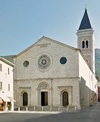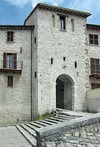

Hermitages on Monte Serrasanta
-
✴Campitella (now demolished)
-
✴Castel Vecchio:
-
•the Eremo di Santo Marzio (13th century), illustrated here; and
-
•Santissima Annunziata (1629);
-
✴Capodacqua:
-
•the Erermo di SS Gervasio e Protasio (now demolished), which joined the Congregazione del Corpo di Cristo (below) in 1345;
-
•the Eremo del Beato Angelo (ca. 1450); and
-
•Santa Maria del Divino Amore (1565); and
-
✴at the summit:
-
•the Eremo di Serrasanta (1547)
Monastero del Corpo di Cristo (demolished)
This congregation was formed in the early 14th century at a monastery outside Porta San Benedetto. It followed a form of the Cistercian Rule that laid particular emphasis on the Eucharist and the Feast of Corpus Domini. The Monastero di SS Gervasio e Protasio at Capodacqua (above) joined the congregation in 1345. The Monastero del Corpo di Cristo was already in poor repair in in 1392, when Pope Boniface IX moved the headquarters of the congregation to Santa Maria in Campis, Foligno. No trace of it survives.
Link to Monastero del Corpo di Cristo
Nunneries of Gualdo Tadino
-
✴Santa Margherita (1328, rebuilt 1453), illustrated here;
-
✴Santa Chiara (1575), formerly Santa Maria di Tadino (below);
-
✴SS Lucia e Maria Maddalena (1381)
Public Palaces of Gualdo Tadino
-
✴Torre Civica (12th century) and the adjacent Palazzo del Podestà (18th century), illustrated here; and
-
✴Palazzo Comunale (1768-9).
Rocca Flea (1247)
-
✴the keep bears the arms of Biordo Michelotto, who built it in 1394; and
-
✴the papal legates adapted it to serve as their residence from 1513.
The fortress passed to the Commune in 1803 and now houses the Museo Civico and the Pinacoteca Comunale.
San Benedetto (1256)
San Donato (1255)
San Facondino (11th century)
San Francesco (ca. 1288-1315)
Santa Maria dei Raccomandati (13th century)
Other Monuments in Gualdo Tadino
-
✴the medieval walls (1242), including its two surviving gates:
-
✴Porta di San Benedetto, illustrated here; and
-
✴Porta San Donato;
-
✴Sant’ Agostino (demolished);
-
✴Sant’ Ippolito (ca. 1670);
-
✴Santa Maria del Piano (1666);
-
✴Santa Maria del Purgo (1647);
-
✴Santa Maria di Rote (1647, rebuilt in 1927);
-
✴Santa Maria di Tadino (1240s), which was transferred to the nuns of Santa Chiara (above) in 1575;
-
✴San Nicolò dei Silvestrini (demolished); and
-
✴San Rocco (1476).
Return to the home page on Gualdo Tadino.











